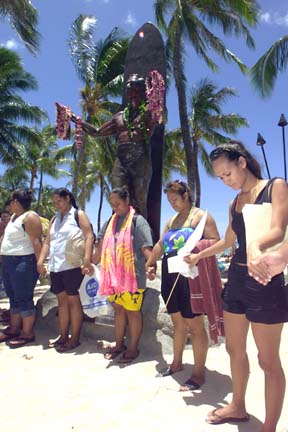
DENNIS ODA / DODA@STARBULLETIN.COM
Hawaiian language teachers formed a circle in front of the Duke Kahanamoku statue in Waikiki and prayed yesterday at the conclusion of the opening ceremony to kick off a week of festivities celebrating the 20th anniversary of 'Aha Punana Leo. Many of the students who grew up in the immersion program are participating in this week's conference as teachers, looking forward to teaching their own students.
Meeting hails
Hawaiian languageThe 'Aha Punana Leo
conference explores
how to boost learning
A group of Hawaiian language preschool teachers poured out of the hotel like a wave, spilling onto the Kalakaua Avenue sidewalk.
Their slippers slapped the sidewalk in unison as they marched, while tourists pushed one another to get a closer look. The group just smiled, continued chanting loud praises for each island's preschool and let the tourists wonder what they were doing.
A teacher's shirt provided an answer. "E Ola Mau ka Olelo Hawaii. Long Live the Hawaiian Language," it read in bright orange letters.
The group of 120 immersion preschool teachers, administrators and parents, determined to continue the Hawaiian language, gathered in Waikiki yesterday for the opening ceremonies of the biannual 'Aha Pünana Leo conference. They will discuss how to better the preschool program and learn from each other's experiences.
In 1985 in Hilo, 'Aha Pünana Leo opened the first Hawaiian immersion preschool, and today there are 22 other preschools, elementary and high schools with 1,700 students in immersion programs.
Many of those students who grew up in the immersion program are participating in this week's conference as teachers, looking forward to teaching their own students. Others were drawn to the language in college and have changed their life to live the language, like Ahulani Wright.
Growing up in San Francisco, she didn't have the opportunity to learn Hawaiian until she attended Brigham Young University-Hawaii in Laie. She said the language connects her to her Hawaiian roots and nurtured a part inside her that wanted to grow. She decided to stay in Hawaii, and devotes her time to teaching at Pünanaleo o Koolauloa.
"It's a chicken-skin feeling to see the keiki speaking Hawaiian," she said. "It's just awesome. I'm excited that my children will go to school there too."
The immersion program is built around families, said longtime teacher Lilinoe Wong. She watches students move through the immersion preschools and eventually graduate from the immersion high schools to come back with their own families.
"The immersion schools provide a sense of belonging and help families grow," she said. Parents have to learn Hawaiian, too, and help the teachers, giving them a sense that this is their school, too, she said.
Teachers hope that with parental involvement the language will live not only in the schools but in the homes and spread through the community.
Makela Bruno-Kidani, director of Pünanaleo of Waimea, dreams of the day when more families will speak Hawaiian. She hopes to be able to speak Hawaiian to policemen, "and buy my groceries, speaking only in Hawaiian," she said.
But there are still many challenges to overcome and attitudes to change.
"I want to see more respect for the language," said Bruno-Kidani. Her school, like many others, is struggling to fill the spaces on the classroom lauhala mats.
"There's lots of competition from big-name schools," she said.
While she knows many parents want their children to "speak and practice the traditions of their culture," there are bigger schools, especially in Waimea.
The immersion schools are a grassroots effort and include the entire family, she said: "It can be hard for the rural communities, especially when there is a lack of funds."
Teachers and administrators spend months every year researching and writing grants, said 'Aha Pünana Leo Director Nämaka Rawlins.
